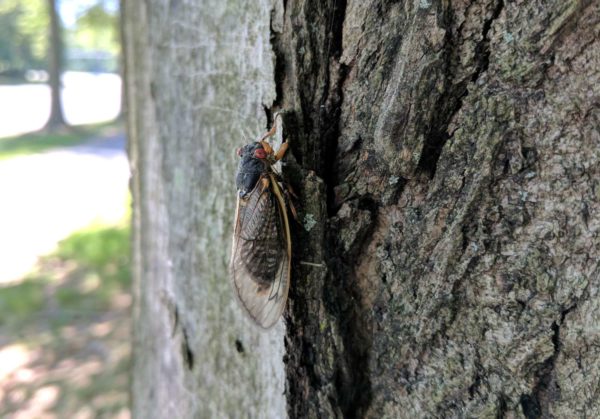The cicadas are coming.
17 years after their last appearance, swarms of cicadas known collectively as periodical cicada Brood X are preparing to stage a sequel this spring, with the D.C. area as the epicenter of a natural phenomenon that will encompass 15 states across the eastern and midwestern U.S.
Tammy Schwab, a naturalist and education and outreach manager for the Fairfax County Park Authority, says the insects are expected to emerge in the county around the middle of May, when the ground temperature reaches about 64 degrees Fahrenheit.
“Cicadas are special because of their extremely long life cycle,” Schwab told Tysons Reporter by email. “Cicadas spend 2-17 years as a larva underground feeding on the roots of trees. Most other insects have much shorter life spans.”
According to the National Wildlife Federation, adult periodical cicadas are black with orange underneath. They are just over an inch in length and boast clear, “membranous,” black-veined wings that span three inches across.
These cicadas are different from annual cicadas, which live underground for two to five years before emerging as adults, typically between May and September. Because their life cycles aren’t as closely synchronized as periodical cicadas, some annual cicadas appear every year.
Fairfax County last saw Brood X — one of 15 periodical cicada broods in the U.S. — at the scale anticipated this spring in 2004, but a handful of the insects were spotted locally in 2017.
“As part of the cicada survival strategy some of each brood can emerge between 1 and 4 years early in case some catastrophe were to destroy all the cicadas in a given emergence,” Schwab explained.
They're coming! This is the year of the 17-year cicada in our area. There will be trillions of them in early summer. They are harmless. They are loud. They are high in protein, if you're into that. They don't social distance. It's a phenomenon of nature to be enjoyed. Can't wait! pic.twitter.com/WR5qWCXq3m
— Fairfax County Parks (@fairfaxparks) March 4, 2021
In comparison, Schwab says “millions” of cicadas could blanket the D.C. region this year, though the numbers could vary across different areas depending on how much land development has occurred over the past 17 years.
Both adult and larval cicadas depend on trees for food, so they tend to be more prevalent in forested areas. However, people in more developed residential neighborhoods might notice them sooner, since the ground warms more quickly in open spaces than in the woods, according to Schwab.
She says the loss of tree cover to development “will definitely decrease populations,” but reforestation prior to an emergence could result in an increase. Fairfax County had stream bank stabilization projects at Snakeden Branch in Reston, Difficult Run in Oakton, Accotink Creek, and Cinnamon Creek in the Wolf Trap area in 2003, the year before Brood X’s last emergence.
“It would be very interesting to see if these project areas had any effect on the population,” Schwab said.
While the appearance of millions of loud, winged insects may sound alarming, cicadas are harmless for humans. The most notable impact will be on newly planted trees, which can be damaged by cicada egg laying.
Schwab advises residents to wait until the fall before planting new trees or utilize insect netting to protect their branches.
She also says people should watch what their pets are eating.
“A few are not likely to hurt pets but too many could cause digestive issues,” Schwab said. “They are edible by people if you’re are brave enough to try it.”
Photo courtesy Fairfax County Park Authority






